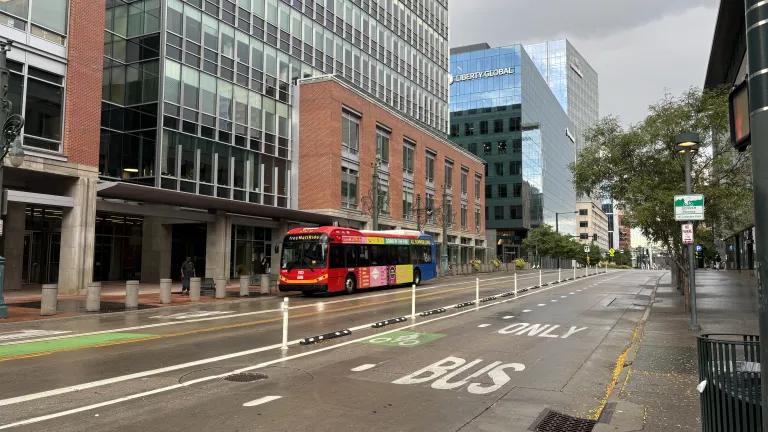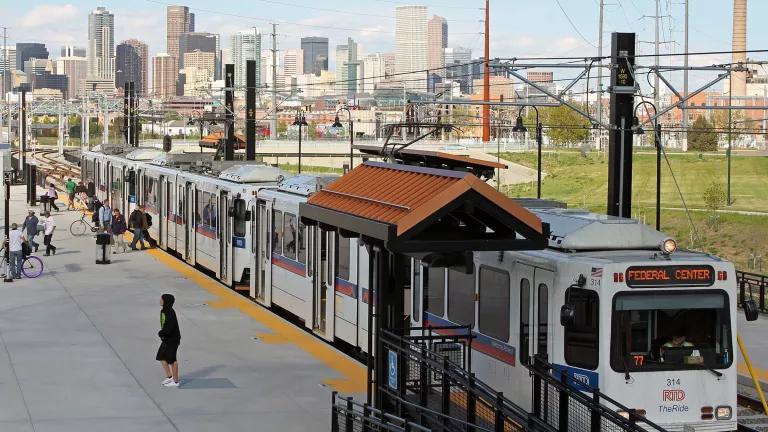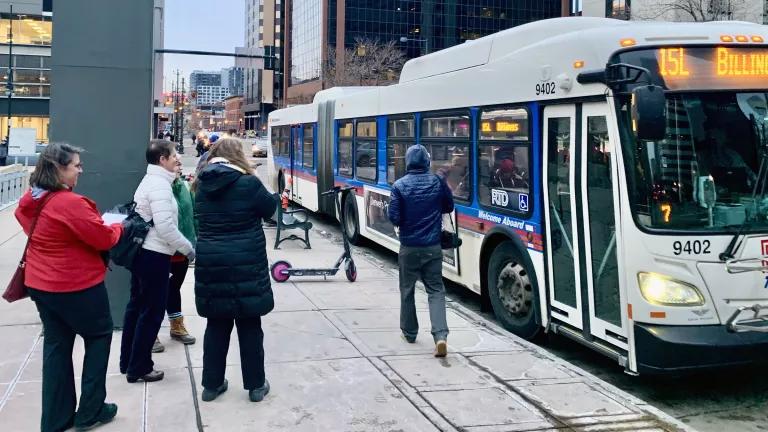Lessons Learned from Colorado’s Transportation Leadership
A look at Colorado provides examples of how to build a transportation system that is just, equitable, and sustainable.

A bus traveling through Denver
Sofia di Tommaso
This blog was authored by Sofie di Tommaso, a Bekenstein Climate Leaders Program Fellow with NRDC's Colorado team. Currently a master of environmental management candidate at Yale University, she is focused on statewide transportation and climate policies, and passionate about finding transportation and city-focused climate solutions.
Revamping transportation systems is critical to addressing the climate crisis. An overreliance on fossil fuel–powered cars—spurred by roadway and highway expansion and underinvestment in other options—has led to transportation being the largest source of greenhouse gas emissions in the United States. A transportation system that is just, equitable, and sustainable requires expanded low-carbon transportation options, safe streets for walking and biking, frequent and affordable transit options, and development and land use patterns that enable car-free travel.
Bridging the gap between the status quo of car-centric travel and a truly interconnected multimodal (walking, biking, and transit) system requires strategic investments and policies across the country. A look at Colorado provides examples of how to shift transportation priorities in the right direction.
Colorado as a national transportation leader
Colorado is a leader in the multimodal transportation space. In less than a decade, it has formed a statewide bus network, leveraged transportation to support local communities, aligned transportation planning with climate goals, piloted free fares programs, created new funding mechanisms, and improved coordination between land use and transportation planning. The following successes in Colorado can offer inspiration to policymakers across geographies.
Statewide bus service
Public transportation is often limited to urban areas. Yet, in 2015, Colorado created an interregional bus system—Bustang—that expanded transit’s benefits to rural and suburban locations. Initially hosting just three routes, the network now operates more than 20. Through Outrider routes like the Craig to Dever line, rural towns have increased access to urban amenities. Similarly, Coloradans can now access skiing opportunities through seasonal Snowstang routes. At operating costs of approximately $10 million per year, Bustang demonstrates that well-designed transit systems can benefit communities outside of city centers while using cost-effective solutions.
Local small-scale investments
Colorado towns experienced heightened economic pressures during the COVID-19 pandemic. In response, Colorado launched the Revitalizing Main Streets grants program in 2021 as part of its $700 million pandemic recovery plan. The program funds local multimodal projects that allow towns to enhance their accessibility, connectivity, and economic recovery. Originally a $30 million grants program, the initiative received $85 million in additional funding through Senate Bill 260 (SB21-260) and continues to support new projects.
Greenhouse gas requirements for transportation planning
As the state’s largest source of greenhouse gas emissions, the current transportation system hinders Colorado from reaching its climate goals. Spurred by legislative requirements in SB21-260, the Colorado Department of Transportation adopted a Greenhouse Gas (GHG) Transportation Planning Standard in 2021 that requires major transportation projects to meet emissions targets directly or using mitigation strategies. Stakeholders spanning senior, youth, justice, environmental, and transportation advocates fought for the standard. Since its adoption, it has produced tangible results, including the cancellation of a highway expansion project that was expected to worsen air quality in two disproportionately impacted communities in Denver, and the reallocation of some funds to Bus Rapid Transit.
Free transit seasonally and for youth
Transportation also contributes to elevated ozone levels in Colorado. In 2022 and 2023, the state piloted a program that offered funding to transit agencies to provide free fares during ozone season. A scaled-down version was continued in 2024 through Senate Bill 032 (SB24-032), which allocates funding for either free ozone-season or free youth fares. The initiative aims to address Colorado’s air quality challenges and recover ridership lost during the pandemic. Due to the Zero Fare for Better Air program, transit agencies experienced a boom in ridership, demonstrating the potential of affordable transportation options.
Dedicated funding for transit
This past legislative session, Colorado added new fees on oil and gas production and rental cars to fund transit service and passenger rail. These funding mechanisms allow the state to generate funding despite Colorado’s Taxpayer’s Bill of Rights (TABOR), a state constitutional amendment that limits the amount of revenue the state can spend and requires voter approval for tax increases. The fees also support state leadership priorities like generating state matching requirements to potentially qualify for federal funding to build a passenger rail line on the Front Range.
Supportive land use policies
Colorado has made recent progress on its transportation and climate goals by modifying land use policies to require denser housing development and remove parking minimums near transit. These policies will support land use patterns that are more conducive to walking, biking, and transit while expanding Colorado’s limited affordable housing stock.
Lessons learned
The state has certainly not solved all of its transportation challenges. Cars still serve as the primary mode of travel; transportation is the state’s largest source of greenhouse gas emissions; and communities continue to grapple with elevated summer ozone levels. However, these policies illustrate methods to improve transportation systems and offer the following lessons:
- Generating a broad coalition of support can help advance transportation options: Successes like the adoption of Colorado’s GHG Transportation Planning Standard demonstrate that working across interest areas can lead to ambitious policies. Tailoring policies and programs to appeal to supporters across equity, accessibility, safety, environmental, and additional focus areas can be a beneficial strategy to increase buy-in.
- Buy-in from leadership is valuable: Colorado’s recently adopted fees on oil and gas production and rental cars will potentially help the state access federal funds to develop a Front Range Passenger Rail—a priority project of the governor’s. Multimodal transportation advocates and policymakers can consider how their strategies align with existing leadership priorities or how to generate support at the leadership level.
- Transportation and land use decisions are stronger when addressed together: Dense, multiuse environments are more conducive to walking, biking, and transit. Colorado’s recent work to align parking and housing requirements with transportation goals can serve as a model of how to craft robust policies that amplify each other.
- Expanding multimodal transportation is an equity opportunity within and outside of city centers: Colorado’s Bustang network has increased rural access to urban amenities through expanded service options. Similarly, Colorado’s free fares programs allowed more people to access daily destinations within and outside of cities by removing transportation-related cost barriers.
- Abundant avenues exist to advance multimodal transportation options, and solutions can be tailored to unique state contexts: Multimodal transportation policies can overcome local constraints and leverage assets to deliver high-quality mobility options. For example, Colorado found solutions in spite of its TABOR-related funding restrictions through new fees on oil and gas production and rental cars. The state also capitalized on its assets to design supportive transportation measures by launching Snowstang to connect Coloradans to skiing opportunities.
- Strategies focused on continued engagement support long-term success: Planning for long-term impact—by building on previous successes or passing measures that shift priorities in an enduring way—can produce stronger policies. For example, the Revitalizing Main Streets grants grew from a small initiative to a more robustly funded program with continuing impact. Likewise, the GHG Transportation Planning Standard created a single standard that will continuously inform state investments.
A key moment for multimodal transportation
With unprecedented federal funding opportunities, now is a critical moment to redirect transportation investments away from historic car-centric patterns of development. States play an important role in this transition as key influencers of where federal dollars are invested. Through policy innovations like those in Colorado, states can design transportation systems that serve both communities and the environment.


